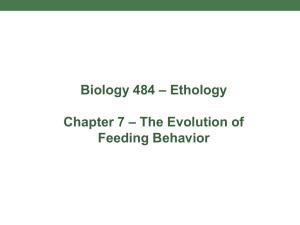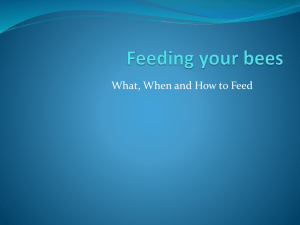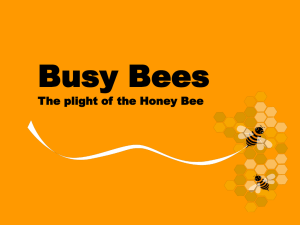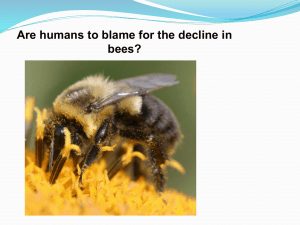Pesticides and Honey Bees
advertisement
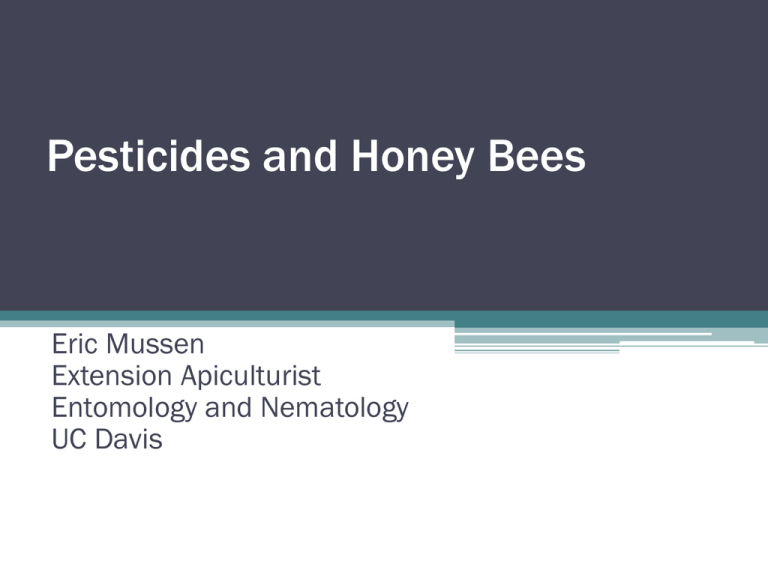
Pesticides and Honey Bees Eric Mussen Extension Apiculturist Entomology and Nematology UC Davis Contributions Honey Bees to California Commercial Agriculture • Honey bees are rented to pollinate nearly 100 crops in California ▫ Fruit, vegetable, nut and forage seed crops ▫ The farm gate value exceeds $6 billion, directly ▫ Beekeepers generate about $150 million from rentals • Honey bee-pollinated crops make up about 1/3 of the normal U.S. diet Contributions Honey Bees to California Commercial Agriculture • California beekeepers produced around 12 million pounds of honey in 2013, worth $23 million ▫ 240,000 pounds of beeswax, a byproduct, was worth around $1 million • California beekeepers produce nearly 1 million queen bees, packaged bees, and nucs worth around $25 million • We are having a hard time keeping our colonies alive ▫ No single cause, just too many sublethal stresses Major Topics to be Covered • • • • • • • Definition of “Pesticide” Pesticide Modes of Action Determining Toxicity of Pesticides to Honey Bees Detoxification of Pesticides Pesticide Residues in Beehives Exposure of Honey Bees to Pesticides Avoiding Pesticide Exposure Definition of “Pesticide” • According to the U.S. Environmental Protection Agency (EPA): “A pesticide is any substance or mixture of substances intended for preventing, destroying, repelling or mitigating any pest.” • According to the California Department of Pesticide Regulation (DPR): “Any substance or product that the user intends to be used for pesticidal poison purposes.” Definition of “Pesticide” • California regulations also cover disinfectants, repellents, wood preservatives, pheromones, attractants, and plant growth regulators • Any word ending in “-cide” means kill: ▫ Insecticide, herbicide, homicide, genocide Modes of Action (How Pesticides Kill) • Pesticides are chosen or designed to interfere with metabolism: ▫ The sum of the chemical reactions that take place within each cell of a living organism and that provide energy for vital processes and for synthesizing new organic material • Animals, plants, fungi, and bacteria rely on their metabolism to live Metabolic Pathways of Live Organisms Metabolic Pathways of Live Organisms Sites of Biochemical Interference chemistrypictures.org Sites of Biochemical Interference en.wikpedia.org Classifications of Pesticides • By type (target pests) ▫ Algicides, antifouling agents, antimicrobials, attractants, biopesticides, biocides, defoliants, desiccants, disinfectants and sanitizers, fungicides, fumigants, herbicides, insecticides, insect growth regulators, miticides, microbial pesticides, molluscicides, nematicides, ovicides, pheromones, plant growth regulators, repellents, and rodenticides Classification of Insecticides • By mode of action ▫ Group 1A – acetylcholine esterase inhibitors Carbamates: carbaryl (Sevin®), carbofuran (Furadan®) (of 25) [atropine antidote] ▫ Group 1B – acetylcholine esterase inhibitors Organophosphates – chlorpyrifos (Lorsban®), malathion, parathion (of 64) ▫ Group 2A – GABA-gated chloride channel antagonists – chlordane, lindane, endosulfan Classification of Insecticides • By mode of action ▫ Group 2B – GABA-gated chloride channel antagonists – fipronil (Maxforce® cockroach and ant baits; Frontline Flea and Tick Control®) ▫ Group 3 – sodium channel modulators – DDT and methoxychlor – Pyrethrins and pyrethroids: Pyganic® (organic sprays), esfenvalerate (Asana®), fluvalinate (Apistan®), permethrin (bug-repellent clothing) Classification of Insecticides • By mode of action ▫ Group 4A – nicotinic acetylcholine receptor agonists/antagonists – imidacloprid, clothianidin, thiamethoxam and dinotefuran are “nitro-substituted” and much more toxic to honey bees than the “cyanosubstituted” acetamiprid and thiacloprid Muscarinic and nicotinic acetylcholine receptors Vertebrates and invertebrates ▫ Group 4B – nicotinic acetylcholine receptor agonists/antagonists – nicotine Other Classifications • Fungicides and herbicides have similar sets of information, including their resistance groups • Fungicides and herbicides have similar modes of action to insecticides, but targeting the biochemistries of fungi and plants ▫ The overlap in metabolic pathways is considerable Measuring Toxicity to Honey Bees • Adult worker LD50 (lethal dose 50 percent) ▫ Topical ▫ Oral • Adult worker LC50 (lethal concentration) ▫ In environment • LD50s and LC50s not usually determined for larval or pupal honey bees • Impacts of chronic sublethal doses on eventual adult longevity not determined, either Considering Synergisms • Textbook definition of synergism ▫ The interaction of things resulting in the overall effect that is greater than the sum of individual effects of any of them. • Example of good synergism: mixed pollen diets better for honey bees than any pollen alone Considering Synergisms • Examples of synergisms harmful to honey bees: ▫ ▫ ▫ ▫ Fluvalinate and coumaphos (more toxic effects) Fluvalinate and chlorothalonil (more toxic effects) Coumaphos and chlorpyrifos (more toxic effects) Chlorothalonil plus chlorpyrifos, then either fluvalinate or coumaphos = no observable differences from controls ▫ Imidacloprid and Nosema ceranae Intestinal parasite proliferates worse than normal ▫ Chlorothalonil and Nosema ceranae Intestinal parasite proliferates worse than normal Considering Synergisms • Fresno to Bakersfield – March 2014 ▫ Beekeepers’ estimate = 80-87,000 colonies affected ▫ DPR’s estimate = “only 10,000 could be verified” • Combination: ▫ Tilt fungicide – no known problems with honey bees ▫ Tourismo insecticide – supposed to be safe for bees EPA data sheet lists “Acceptable” where we expect to see LD50s ▫ Adjuvant (?) – now, mostly “penetrants” Considering Synergism • Advertising claim of one penetrant manufacturer ▫ “Even moves chemicals through the waxy cuticular layer of Eucalyptus leaves” • What is the primary protection for an insect to chemical poisoning? ▫ It’s waxy cuticular layer Detoxification of Pesticides • Basic systems to make pesticides water-soluble for excretion ▫ ▫ ▫ ▫ ▫ Oxidation (loss of hydrogen) Reduction (gain of hydrogen) Hydrolysis (reaction with, or addition of water) Hydration (decomposition reaction with water) Dehalogenation (elimination of halides) • Phase I requires cytochrome P450 enzymes Cytochrome P450s in Honey Bees • Fewer types of P450 enzymes in honey bee genome than in mosquitoes or fruit flies • Fewer replicate genes for each P450 enzyme compared to mosquitoes and fruit flies • Piperonyl butoxide (adjuvant) prevents production of P450 enzymes • Other, tank-mix agricultural adjuvants just beginning to get serious attention ▫ Toxicity and ability to convey chemicals across membranes are important considerations Detoxification of Pesticides • Phase II requires many functional enzymes to form conjugates that can carry the toxins out of the body: ▫ Sulfation; glucoronidation; glutathione conjugation; acetylation; amino acid conjugation; or methylation • Each of these processes also can be targeted to disrupt an organism Results of Residue Analyses • Multi-year studies on residues (USDA/AMS) ▫ Two sources of beehive samples nearly pesticide-free Stored honey and immature bees ▫ Three types of samples very apt to have significant residues associated with them Stored pollens Beeswax Adult bees ▫ So far, residues of about 150 of the 200 parental and major breakdown products of our agricultural chemicals have been found Exposure of Honey Bees to Pesticides • Direct hit ▫ Foraging in treated area at time of application ▫ Drift over and into the hives • Contact with toxic residues ▫ Entering a treated area before toxic residue dries, or breaks down, on attractive bloom ▫ Foraging water over which pesticide has be applied or into which pesticide has run (chemigation) ▫ Consuming contaminated pollen (or nectar) brought back to the hive before the exposed foragers die neonics and other systemics Avoiding Pesticide Exposure • Try to choose apiary locations away from pesticide use ▫ Hives sometimes can be covered for short periods when applications are expected: mosquito abatement, agricultural fields, orchards, etc. ▫ Encourage necessary applications be made when pollen and pollen-collecting bees are not going to be contaminated Best advice we can share! Avoiding Pesticide Exposure • GET THE WORD OUT! ▫ Right now the world is on the side of the bees ▫ Targeting neighbors, nursery store operators, hardware store operators, retail store operators, farmers’ market visitors, greens-keepers, PCA’s, Farm Advisors, professional and public service organizations that ALL PESTICIDES have demonstrable physiological effects on honey bees if the bees come into contact with the materials Latest Extension Publication on Honey Bee Toxicity (2013) • “How to Reduce Bee Poisoning From Pesticides” ▫ Pacific Northwest Extension Publication PNW591 ▫ By L. Hooven, R. Sagili, and E. Johansen ▫ Chemicals cross-indexed by active ingredient and by product name ▫ 34 pages • May be purchased from Washington State or Oregon State Universities for $5, plus shipping ▫ Available as free PDF on the Internet http://www.orsba.org/htdocs/home.php, then click on the link to the publication EPA Residual Times (RT25) Tables • Time to 25 percent mortality of foragers following application ▫ Sun exposure, temperature, and humidity all play big roles ▫ Has to be a range, in hours or days over a year for Penncap-M in “bee bread” (stored pollen) • Free download on the Internet: ▫ Enter “Residual Time to 25% Bee Mortality (RT25) Data” in your browser ▫ The direct URL runs on for miles Speaker Contacts • • • • • • Eric Mussen Extension Apiculturist Emeritus UC Davis Phone: 530-752-0472 Email: ecmussen@ucdavis.edu URL: entomology.ucdavis.edu/Faculty/Eric_C_Mussen/


